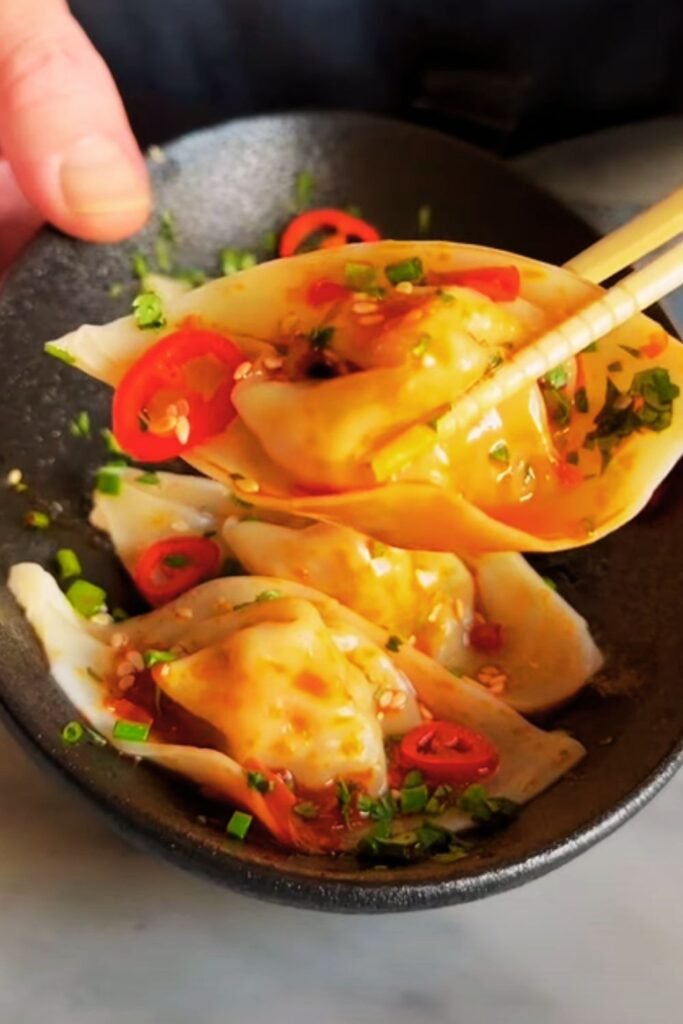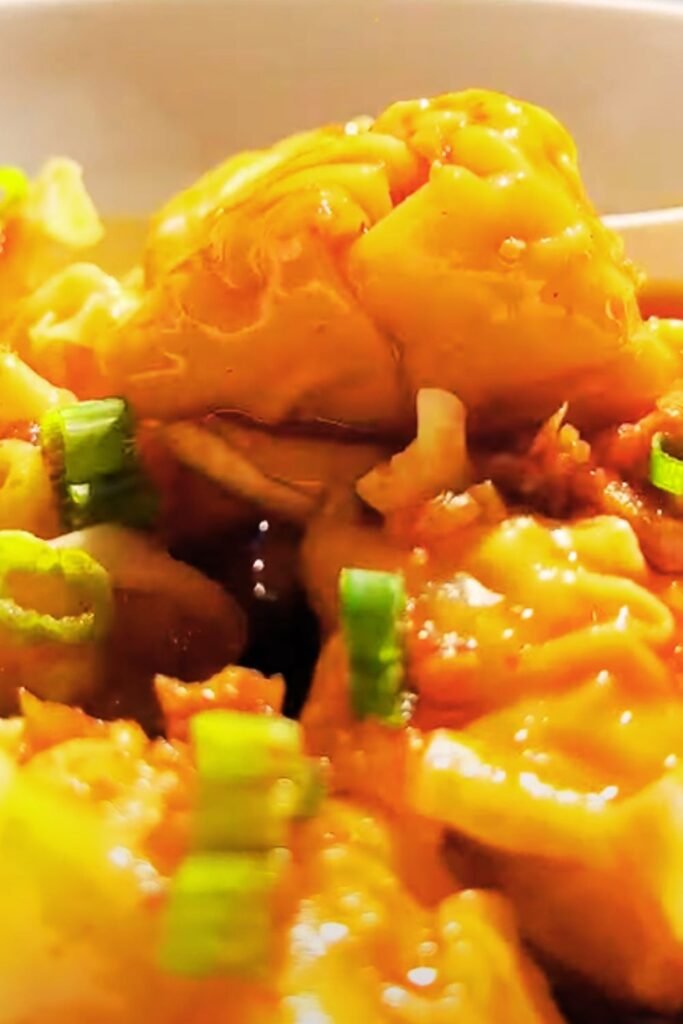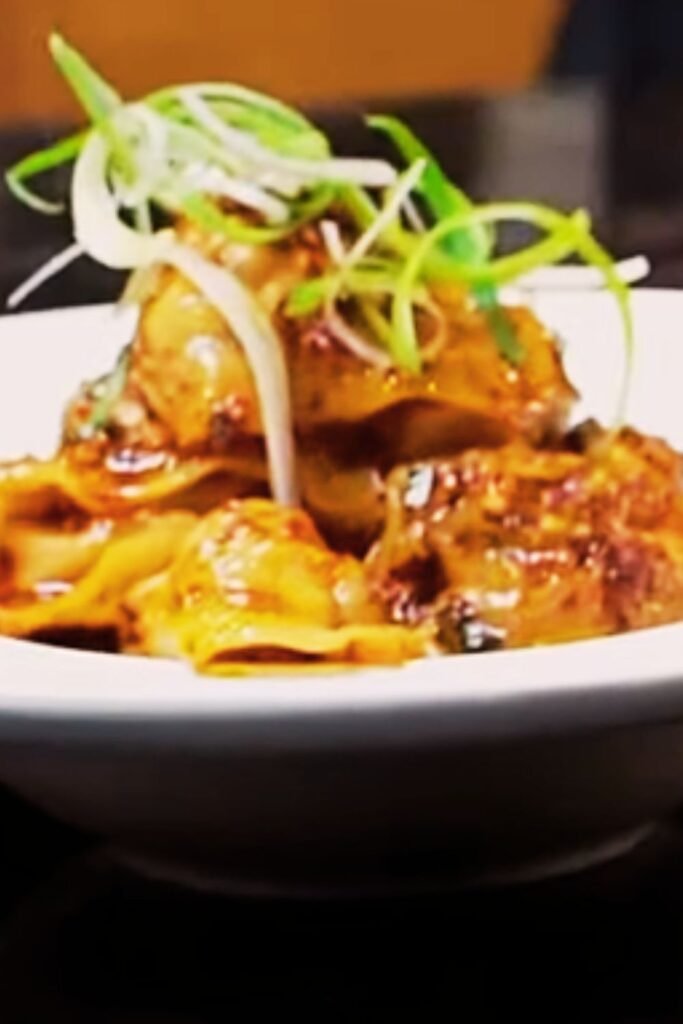I’ve been making wontons for over a decade, and let me tell you – there’s something absolutely magical about that first bite into a perfectly crafted spicy chicken wonton. The delicate wrapper gives way to reveal a burst of savory, spicy filling that dances on your tongue with layers of heat and flavor. Today, I’m sharing my foolproof recipe that transforms simple ingredients into restaurant-quality wontons that’ll have your family begging for more.
When I first attempted wontons in my tiny apartment kitchen years ago, I was intimidated by the folding technique and worried about getting the spice levels just right. After countless batches and plenty of trial and error, I’ve perfected a method that delivers consistently delicious results every single time. These spicy chicken wontons strike the perfect balance between heat and flavor, making them ideal for both casual weeknight dinners and impressive dinner parties.
Understanding Wontons: The Foundation of Flavor
Wonton: A traditional Chinese dumpling consisting of a thin wrapper filled with seasoned meat, vegetables, or seafood, typically boiled, steamed, or fried.
Wrapper: The delicate, paper-thin dough that encases the filling, usually made from wheat flour, water, and sometimes egg.
Heat Level: The intensity of spiciness in the filling, achieved through various chili-based ingredients and spices.
Folding Technique: The method of sealing the wrapper around the filling to prevent leakage during cooking.
The beauty of wontons lies in their versatility. While my spicy chicken version brings serious heat, the technique I’m sharing can be adapted to countless flavor profiles. I’ve found that the key to exceptional wontons isn’t just in the filling – it’s in understanding how each component works together to create that perfect bite.
Essential Ingredients for Perfect Spicy Chicken Wontons
Creating outstanding spicy chicken wontons starts with selecting quality ingredients. I’ve learned through experience that each component plays a crucial role in the final dish, and there are no real shortcuts when it comes to achieving that restaurant-quality taste.
The Protein Foundation
For the chicken, I always use ground chicken thigh meat rather than breast meat. The higher fat content keeps the filling moist and flavorful, preventing that dry, crumbly texture that can plague lean ground chicken breast. When I can’t find pre-ground thigh meat, I simply purchase boneless thighs and pulse them in my food processor until they reach the perfect consistency.
Building the Heat Profile
The spice blend in these wontons creates layers of heat that build gradually rather than overwhelming your palate immediately. I combine fresh ginger, garlic, and scallions with dried chili flakes, sriracha sauce, and a touch of Chinese five-spice powder. This combination delivers warmth, depth, and that satisfying burn that keeps you reaching for more.

Wrapper Selection and Storage
Choosing the right wonton wrappers makes an enormous difference in your final product. I prefer thin, square wrappers over thick ones because they create a better filling-to-wrapper ratio and cook more evenly. Fresh wrappers from the refrigerated section work best, but frozen ones are perfectly acceptable if thawed properly. Always keep unused wrappers covered with a damp towel to prevent them from drying out during assembly.
Detailed Nutritional and Ingredient Analysis
| Component | Quantity per Serving (4 wontons) | Calories | Protein (g) | Fat (g) | Carbs (g) | Sodium (mg) |
|---|---|---|---|---|---|---|
| Ground Chicken Thigh | 2 oz | 140 | 18 | 7 | 0 | 65 |
| Wonton Wrappers (4 pieces) | 1 oz | 80 | 3 | 0.5 | 16 | 180 |
| Ginger (fresh) | 1 tsp | 2 | 0 | 0 | 0.5 | 0 |
| Garlic | 1 clove | 4 | 0.2 | 0 | 1 | 1 |
| Scallions | 1 tbsp | 3 | 0.2 | 0 | 0.7 | 2 |
| Sriracha Sauce | 1 tsp | 5 | 0.1 | 0.1 | 1 | 100 |
| Sesame Oil | 1/4 tsp | 10 | 0 | 1.1 | 0 | 0 |
| Soy Sauce | 1/2 tsp | 3 | 0.5 | 0 | 0.5 | 290 |
| Total per Serving | – | 247 | 22 | 8.7 | 19.7 | 638 |
Spice Level Customization Guide
| Heat Level | Sriracha (tsp) | Red Pepper Flakes (tsp) | Fresh Chilies | Cayenne Powder (pinch) | Taste Profile |
|---|---|---|---|---|---|
| Mild | 1/2 | 1/4 | None | None | Gentle warmth, family-friendly |
| Medium | 1 | 1/2 | 1/2 jalapeño, minced | Small pinch | Noticeable heat, moderate burn |
| Hot | 1 1/2 | 3/4 | 1 jalapeño, minced | 1/8 tsp | Significant heat, lingering warmth |
| Extra Hot | 2 | 1 | 1 serrano pepper, minced | 1/4 tsp | Intense heat, serious burn |
| Fire | 2 1/2 | 1 1/4 | 1 Thai chili, minced | 1/2 tsp | Extreme heat, not for beginners |
Step-by-Step Preparation Method
Preparing the Spicy Chicken Filling
I start by combining one pound of ground chicken thigh with finely minced aromatics. The key here is getting everything evenly distributed throughout the meat. I use my hands to gently mix the ingredients, being careful not to overwork the mixture, which can result in tough, dense wontons.
My spice mixture includes two tablespoons of freshly grated ginger, four cloves of minced garlic, three finely chopped scallions, two tablespoons of sriracha sauce, one tablespoon of soy sauce, one teaspoon of sesame oil, one teaspoon of red pepper flakes, and half a teaspoon of Chinese five-spice powder. I also add a beaten egg to bind everything together and one tablespoon of cornstarch to help maintain the texture during cooking.
Mastering the Folding Technique
The folding process intimidated me initially, but I’ve developed a foolproof method that creates beautifully sealed wontons every time. I place about one teaspoon of filling in the center of each wrapper, being careful not to overfill, which can cause bursting during cooking.
First, I brush the edges of the wrapper with water using my finger. Then I fold the wrapper in half diagonally to form a triangle, pressing firmly to seal the edges and eliminate air bubbles. Next, I bring the two bottom corners of the triangle together, overlapping them slightly and pressing to seal. This creates the classic wonton shape that holds together perfectly during cooking.

Cooking Methods and Techniques
Boiling Method
Boiling produces the most traditional texture and allows the spicy flavors to shine through without any additional oil. I bring a large pot of salted water to a rolling boil and carefully add the wontons, stirring gently to prevent sticking. Fresh wontons typically take 4-5 minutes to cook, floating to the surface when done. I remove them with a slotted spoon and serve immediately.
Pan-Frying for Crispy Texture
Pan-frying creates an incredible contrast between the crispy bottom and tender top. I heat two tablespoons of vegetable oil in a non-stick pan over medium-high heat, then place the wontons in a single layer. After the bottoms turn golden brown (about 2-3 minutes), I add half a cup of water, cover immediately, and steam for another 3-4 minutes until the water evaporates.
Steaming for Delicate Results
Steaming produces the most delicate texture and is my preferred method when serving these as an appetizer. I line my steamer basket with parchment paper or cabbage leaves to prevent sticking, then steam the wontons for 8-10 minutes over rapidly boiling water.
Sauce Pairings and Serving Suggestions
The right dipping sauce can elevate these spicy wontons from good to extraordinary. My go-to sauce combines three tablespoons of soy sauce, one tablespoon of black vinegar, one teaspoon of sesame oil, half a teaspoon of sugar, and a sprinkle of chopped scallions. For extra heat, I add a few drops of chili oil.
Complementary Side Dishes
These wontons pair beautifully with light, refreshing sides that balance the heat. I often serve them alongside cucumber salad dressed with rice vinegar and a touch of sugar. Steamed bok choy with garlic provides a nutritious vegetable component, while jasmine rice helps tame the spice level for those who need a cooling element.
For a complete meal, I like to serve these wontons in a clear broth with shiitake mushrooms and snow peas. The gentle broth allows the spicy filling to remain the star while providing a satisfying, warming base that makes this dish perfect for cooler weather.

Storage and Make-Ahead Tips
One of the best aspects of wontons is how well they freeze, making them perfect for meal prep or entertaining. I assemble large batches when I have time, then freeze them on parchment-lined baking sheets before transferring to freezer bags. Properly frozen wontons keep for up to three months and can be cooked directly from frozen with just an extra minute or two of cooking time.
For fresh wontons, I store assembled but uncooked ones in the refrigerator for up to 24 hours, covered with a damp towel. This actually improves the texture slightly as the wrapper has time to absorb some moisture from the filling.
Troubleshooting Common Issues
Preventing Wrapper Breakage
Broken wrappers usually result from overfilling or using wrappers that have dried out. I always keep my workspace organized with a bowl of water for sealing and a damp towel covering unused wrappers. If wrappers seem particularly fragile, I let them sit at room temperature for 10-15 minutes to become more pliable.
Achieving Consistent Heat Levels
Inconsistent spice levels often happen when ingredients aren’t evenly distributed. I’ve learned to mix the spices into a small paste with a bit of soy sauce before incorporating them into the chicken. This ensures every wonton delivers the same heat level.
Preventing Soggy Bottoms
When pan-frying, soggy bottoms usually indicate the pan wasn’t hot enough initially or too much water was added during steaming. I always test the pan temperature with a drop of water – it should sizzle and evaporate immediately when the pan is ready.
Variations and Adaptations
While this spicy chicken version is my favorite, the technique adapts beautifully to other proteins and flavor profiles. I’ve made excellent versions using ground turkey with Thai basil and lime zest, ground pork with ginger and hoisin sauce, and even a vegetarian version with mushrooms and water chestnuts.
For dietary restrictions, gluten-free wrappers work well, though they require gentler handling. The filling can be adapted for keto diets by omitting the cornstarch and using coconut aminos instead of soy sauce.
Questions and Answers
Q: How spicy are these wontons compared to typical restaurant versions?
These wontons pack significantly more heat than most restaurant versions. I designed them for people who genuinely enjoy spicy food, rating them around medium-hot on the heat scale. The spice builds gradually and has good depth rather than just pure heat.
Q: Can I make these wontons ahead of time for a party?
Absolutely! I actually prefer making them a day ahead. Assemble the wontons completely, then store them covered in the refrigerator. They can go straight from fridge to cooking pot, making party prep much easier.
Q: What’s the best way to reheat leftover cooked wontons?
I find that pan-frying leftover wontons works best, giving them a crispy exterior that’s often better than the original texture. Steam them for 2-3 minutes if you prefer to maintain the original soft texture.
Q: How can I tell when the wontons are properly cooked?
Properly cooked wontons float to the surface when boiled and feel firm but not hard when gently pressed. The wrapper should be translucent, and you should be able to see the filling through it slightly.
Q: Can I substitute the ground chicken with another protein?
Ground pork works excellently and is actually more traditional. Ground turkey also works well, though it can be slightly drier. I add an extra teaspoon of sesame oil when using turkey to compensate for the lower fat content.
Q: Why do my wrappers keep tearing during folding?
Tearing usually happens when wrappers are too dry or you’re overfilling them. Keep unused wrappers under a damp towel and use only about a teaspoon of filling per wrapper. If wrappers seem stiff, let them sit at room temperature for 15 minutes.
Q: How long do these keep in the freezer?
Properly frozen wontons maintain quality for up to three months. I freeze them on baking sheets first, then transfer to freezer bags to prevent sticking. Label with the date and heat level for easy identification.
Q: Can I bake these wontons instead of boiling or frying?
While baking isn’t traditional, it does work. Brush with oil and bake at 400°F for 12-15 minutes, turning once halfway through. The texture will be different – more crispy throughout rather than tender.
Q: What’s the secret to getting restaurant-quality flavor at home?
The secret is in the balance of aromatics and not being afraid of the ginger and garlic. I use much more fresh ginger than most recipes call for, and I let the filling rest for 30 minutes before assembling to let the flavors meld.
Q: How do I prevent the wontons from sticking together when cooking?
Use plenty of water when boiling and stir gently right after adding them to the pot. For steaming, make sure they don’t touch each other in the steamer basket. A light coating of oil on the steamer liner also helps.